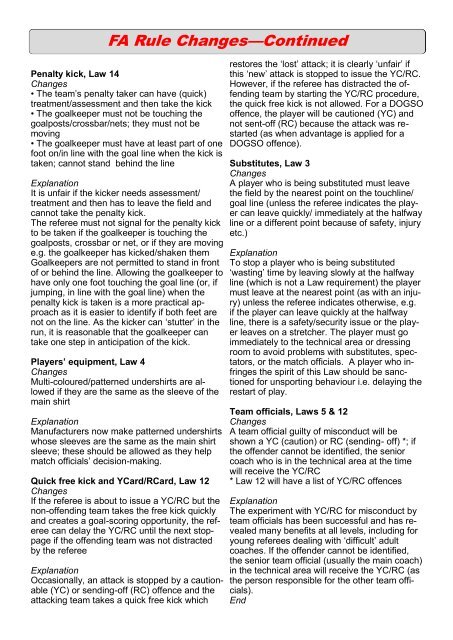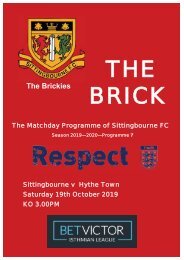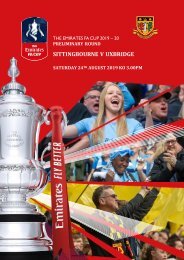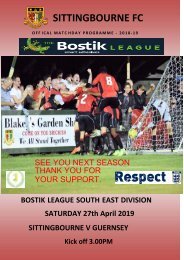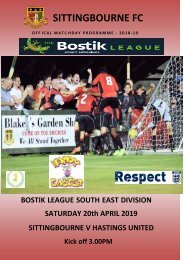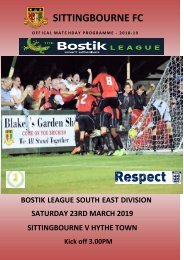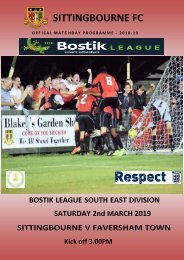Match Day Programme Sittingbourne v Horsham 6th April 2019
Match Day Programme Sittingbourne v Horsham 6th April 2019
Match Day Programme Sittingbourne v Horsham 6th April 2019
You also want an ePaper? Increase the reach of your titles
YUMPU automatically turns print PDFs into web optimized ePapers that Google loves.
FA Rule Changes—Continued<br />
Penalty kick, Law 14<br />
Changes<br />
• The team’s penalty taker can have (quick)<br />
treatment/assessment and then take the kick<br />
• The goalkeeper must not be touching the<br />
goalposts/crossbar/nets; they must not be<br />
moving<br />
• The goalkeeper must have at least part of one<br />
foot on/in line with the goal line when the kick is<br />
taken; cannot stand behind the line<br />
Explanation<br />
It is unfair if the kicker needs assessment/<br />
treatment and then has to leave the field and<br />
cannot take the penalty kick.<br />
The referee must not signal for the penalty kick<br />
to be taken if the goalkeeper is touching the<br />
goalposts, crossbar or net, or if they are moving<br />
e.g. the goalkeeper has kicked/shaken them<br />
Goalkeepers are not permitted to stand in front<br />
of or behind the line. Allowing the goalkeeper to<br />
have only one foot touching the goal line (or, if<br />
jumping, in line with the goal line) when the<br />
penalty kick is taken is a more practical approach<br />
as it is easier to identify if both feet are<br />
not on the line. As the kicker can ‘stutter’ in the<br />
run, it is reasonable that the goalkeeper can<br />
take one step in anticipation of the kick.<br />
Players’ equipment, Law 4<br />
Changes<br />
Multi-coloured/patterned undershirts are allowed<br />
if they are the same as the sleeve of the<br />
main shirt<br />
Explanation<br />
Manufacturers now make patterned undershirts<br />
whose sleeves are the same as the main shirt<br />
sleeve; these should be allowed as they help<br />
match officials’ decision-making.<br />
Quick free kick and YCard/RCard, Law 12<br />
Changes<br />
If the referee is about to issue a YC/RC but the<br />
non-offending team takes the free kick quickly<br />
and creates a goal-scoring opportunity, the referee<br />
can delay the YC/RC until the next stoppage<br />
if the offending team was not distracted<br />
by the referee<br />
Explanation<br />
Occasionally, an attack is stopped by a cautionable<br />
(YC) or sending-off (RC) offence and the<br />
attacking team takes a quick free kick which<br />
restores the ‘lost’ attack; it is clearly ‘unfair’ if<br />
this ‘new’ attack is stopped to issue the YC/RC.<br />
However, if the referee has distracted the offending<br />
team by starting the YC/RC procedure,<br />
the quick free kick is not allowed. For a DOGSO<br />
offence, the player will be cautioned (YC) and<br />
not sent-off (RC) because the attack was restarted<br />
(as when advantage is applied for a<br />
DOGSO offence).<br />
Substitutes, Law 3<br />
Changes<br />
A player who is being substituted must leave<br />
the field by the nearest point on the touchline/<br />
goal line (unless the referee indicates the player<br />
can leave quickly/ immediately at the halfway<br />
line or a different point because of safety, injury<br />
etc.)<br />
Explanation<br />
To stop a player who is being substituted<br />
‘wasting’ time by leaving slowly at the halfway<br />
line (which is not a Law requirement) the player<br />
must leave at the nearest point (as with an injury)<br />
unless the referee indicates otherwise, e.g.<br />
if the player can leave quickly at the halfway<br />
line, there is a safety/security issue or the player<br />
leaves on a stretcher. The player must go<br />
immediately to the technical area or dressing<br />
room to avoid problems with substitutes, spectators,<br />
or the match officials. A player who infringes<br />
the spirit of this Law should be sanctioned<br />
for unsporting behaviour i.e. delaying the<br />
restart of play.<br />
Team officials, Laws 5 & 12<br />
Changes<br />
A team official guilty of misconduct will be<br />
shown a YC (caution) or RC (sending- off) *; if<br />
the offender cannot be identified, the senior<br />
coach who is in the technical area at the time<br />
will receive the YC/RC<br />
* Law 12 will have a list of YC/RC offences<br />
Explanation<br />
The experiment with YC/RC for misconduct by<br />
team officials has been successful and has revealed<br />
many benefits at all levels, including for<br />
young referees dealing with ‘difficult’ adult<br />
coaches. If the offender cannot be identified,<br />
the senior team official (usually the main coach)<br />
in the technical area will receive the YC/RC (as<br />
the person responsible for the other team officials).<br />
End


